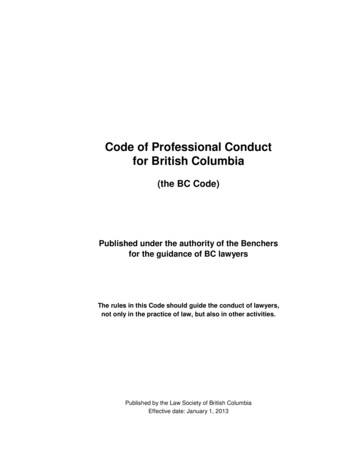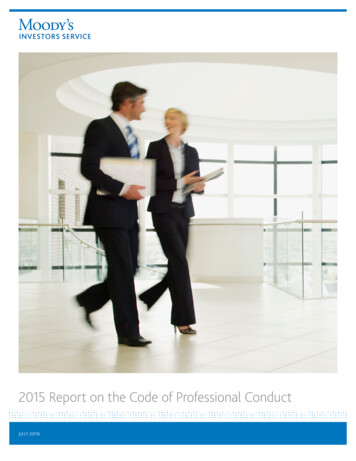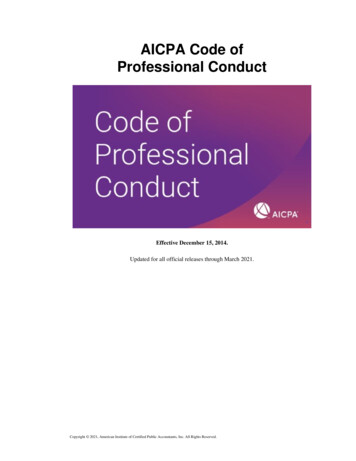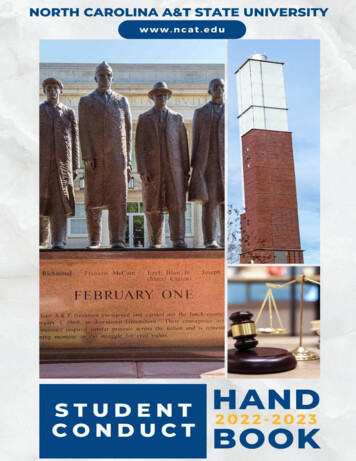
Transcription
Code of Professional Conductfor British Columbia(the BC Code)Published under the authority of the Benchersfor the guidance of BC lawyersThe rules in this Code should guide the conduct of lawyers,not only in the practice of law, but also in other activities.Published by the Law Society of British ColumbiaEffective date: January 1, 2013
Table of ContentsIntroduction .viiChapter 1 – Interpretation and Definitions1. 1 Definitions .1Chapter 2 – Standards of the Legal Profession2.1 Canons of Legal EthicsTo the state .To courts and tribunals .To the client .To other lawyers .To oneself .334562.2 Integrity .6Chapter 3 – Relationship to Clients3.1 CompetenceDefinitions .Competence .9103.2 Quality of serviceQuality of service .Limited scope retainers .Honesty and candour .Language rights .When the client is an organization .Encouraging compromise or settlement .Threatening criminal or regulatory proceedings .Inducement for withdrawal of criminal or regulatory proceedings .Dishonesty, fraud by client .Dishonesty, fraud when client an organization .Clients with diminished capacity .Restricting future representation .121414.114.114.2151515161719203.3 ConfidentialityConfidential information .Use of confidential information .[06/2017]i2022
Code of Professional Conduct for British ColumbiaLawyers’ obligation to claim privilege when faced with requirement tosurrender document .Future harm / public safety exception .23233.4 ConflictsDuty to avoid conflicts of interest .Consent .Dispute .Concurrent representation with protection of confidential client information .Joint retainers .Acting against former clients .Short-term summary legal services .Conflicts from transfer between law firms .Application of rule .Law firm disqualification .Transferring lawyer disqualification .Lawyer due diligence for non-lawyer staff .Conflicts with clients .Doing business with a client .Independent legal advice .Investment by client when lawyer has an interest .Borrowing from clients .Certificate of independent legal advice .Lawyers in loan or mortgage transactions .Guarantees by a lawyer .Testamentary instruments and gifts .Judicial interim release .Space-sharing arrangements 2433.5 Preservation of clients’ propertyPreservation of clients’ property .Notification of receipt of property .Identifying clients’ property .Accounting and delivery .434444443.6 Fees and disbursementsReasonable fees and disbursements .Contingent fees and contingent fee agreements .Statement of account .Joint retainer .Division of fees and referral fees .Exception for multi-disciplinary practices .ii444646474748[06/2017]
Table of ContentsPayment and appropriation of funds .Prepaid legal services plan .49493.7 Withdrawal from representationWithdrawal from representation .Optional withdrawal .Non-payment of fees .Withdrawal from criminal proceedings .Obligatory withdrawal .Manner of withdrawal .Confidentiality .Duty of successor lawyer .4951515253535555Chapter 4 – Marketing of Legal Services4.2 MarketingApplication of rule .Definitions .Content and format of marketing activities .Notary public .Designation .57575758584.3 Advertising nature of practicePreferred areas of practice .Specialization .Real estate sales .Multi-disciplinary practice .58595959Chapter 5 – Relationship to the Administration of Justice5.1 The lawyer as advocateAdvocacy .Incriminating physical evidence .Duty as prosecutor .Disclosure of error or omission .Courtesy .Undertakings .Agreement on guilty plea .616464.264.26565655.2 The lawyer as witnessSubmission of evidence .Appeals .[06/2017]iii6666
Code of Professional Conduct for British Columbia5.3 Interviewing witnessesInterviewing witnesses .675.4 Communication with witnesses giving evidenceCommunication with witnesses giving evidence .675.5 Relations with jurorsCommunications before trial .Disclosure of information .Communication during trial .6869695.6 The lawyer and the administration of justiceEncouraging respect for the administration of justice .Seeking legislative or administrative changes .Security of court facilities .6970715.7 Lawyers and mediatorsRole of mediator .71Chapter 6 – Relationship to Students, Employees, and Others6.1 SupervisionDirect supervision required .Definitions .Delegation .Suspended or disbarred lawyers .Electronic registration of documents .Real estate assistants .7373747676.1776.2 StudentsRecruitment and engagement procedures .Duties of principal .Duties of articled student .7878786.3 Harassment and discrimination .78Chapter 7 – Relationship to the Society and Other Lawyers7.1 Responsibility to the society and the profession generallyRegulatory compliance .Meeting financial obligations .Duty to report .Encouraging client to report dishonest conduct .iv81818283[06/2017]
Table of Contents7.2 Responsibility to lawyers and othersCourtesy and good faith .Communications .Inadvertent communications .Undertakings and trust conditions .Trust cheques .Real estate transactions .8384868687887.3 Outside interests and the practice of lawMaintaining professional integrity and judgment .887.4 The lawyer in public officeStandard of conduct .897.5 Public appearances and public statementsCommunication with the public .Interference with right to fair trial or hearing .90917.6 Preventing unauthorized practice .917.7 Retired judges returning to practice .917.8 Errors and omissionsInforming client of errors or omission .Notice of claim .Co-operation .Responding to client’s claim .92929393Appendix A – Affidavits, Solemn Declarations and Officer CertificationsAffidavits and solemn declarations .Witnessing the execution of an instrument .9599Appendix B – Family Law MediationDefinitions .Disqualifications .Obligations of family law mediator or arbitrator or parenting coordinatorwhen participants unrepresented .Obligations of family law mediator or parenting coordinator .Obligations of family law arbitrator .Lawyer with dual role .[06/2017]v101102102102.1102.1102.2
Code of Professional Conduct for British ColumbiaAppendix C – Real Property TransactionsApplication .Acting for parties with different interests .Simple conveyance .Advice and consent .Foreclosure proceedings .Unrepresented parties in a real property transaction .103103103105105106Appendix D – Conflicts Arising as a Result of Transfer Between Law Firms[Appendix D rescinded 11/2016 – see rules 3.4-17 to 3.4-23]Appendix E – Supervision of ParalegalsKey concepts .Best practices for supervising paralegals: .Best practices for training paralegals .A checklist for assessing the competence of paralegals .Screening for family violence .Designated paralegals giving legal advice .vi113113114114115116[06/2017]
Introduction(1)One of the hallmarks of civilized society is the rule of law. Its importance is reflected inevery legal activity in which citizens engage. As participants in a justice system thatadvances the rule of law, lawyers hold a unique and important role in society. Selfregulatory powers have been granted to the legal profession in Canada on theunderstanding that the profession will exercise those powers in the public interest. Part ofthat responsibility is ensuring the appropriate regulation of the professional conduct oflawyers. Members of the legal profession who draft, argue, interpret and challenge the lawof the land can attest to Canada’s robust legal system. They also acknowledge the public’sreliance on the integrity of the people who work within the legal system and the authorityexercised by the governing bodies of the profession. While lawyers are consulted for theirknowledge and abilities, more than mere technical proficiency is expected of them. Aspecial ethical responsibility comes with membership in the legal profession. This Code ofProfessional Conduct for British Columbia attempts to define and illustrate thatresponsibility in terms of a lawyer’s professional relationships with clients, the justicesystem and other members of the profession.(2)The Legal Profession Act provides that it is the object and duty of the Law Society ofBritish Columbia to uphold and protect the public interest in the administration of justice.A central feature of that duty is to ensure that lawyers can identify and maintain the higheststandards of ethical conduct. This Code attempts to assist lawyers to achieve that goal.While the Code should be considered a reliable and instructive guide for lawyers, theobligations it identifies are only the minimum standards of professional conduct expectedof members of the profession. Lawyers are encouraged to aspire to the highest standards ofcompetence, integrity and honour in the practice of their profession, whether or not suchstandards are formally addressed in the Code.(3)The Code is published under the authority of the Benchers of the Law Society of BritishColumbia for the guidance of BC lawyers. It is significantly related to the Federation ofLaw Societies’ Model Code of Professional Conduct, though there are points of variancefrom the Model Code that the Benchers have considered to be appropriate for guidingpractice in British Columbia. Where there is a corresponding provision in the Model Code,the numbering of the BC Code is similar to that of the Model Code. The BC Code is not aformal part of the Law Society Rules but, rather, an expression of the views of theBenchers about standards that British Columbia lawyers must meet in fulfilling theirprofessional obligations.[03/2017]vii
Code of Professional Conduct for British Columbia(4)The Code is divided into three components: rules, commentary and appendices. Each ofthese components contain some statements that are mandatory, some that are advisory andothers with both mandatory and advisory elements. Some issues are dealt with in more thanone place in the Code, and the Code itself is not exhaustive of lawyers’ professionalconduct obligations. In determining lawyers’ professional obligations, the Code must beconsulted in its entirety and lawyers should be guided in their conduct equally by thelanguage in the rules, commentary and appendices. Mandatory statements have equal forcewherever they appear in the Code.(5)A breach of a provision of the Code by a lawyer may or may not be the basis ofdisciplinary action against that lawyer. A decision by the Law Society to take such actionwill include a consideration of the language of the provision itself and the nature andseriousness of the conduct in question.(6)The correct or best answer to ethical questions that arise in the practice or lives of lawyersmay often be difficult to discern, whether or not the Code addresses the question directly.Lawyers should always be aware that discussion of such questions with Benchers, LawSociety practice advisors, the Law Society’s Ethics Committee or other experienced andtrusted colleagues is the approach most likely to identify a reasonable course of actionconsistent with lawyers’ ethical obligations. This Code is intended to be a valuable assetfor lawyers in the analysis, discussion and resolution of such issues.[Introduction added 12/2016]viii[03/2017]
Chapter 1 – Interpretation and Definitions1.1Definitions1.1-1In this Code, unless the context indicates otherwise,“associate” includes:(a)a lawyer who practises law in a law firm through an employment or other contractualrelationship; and(b)a non-lawyer employee of a multi-discipline practice providing services that supportor supplement the practice of law;“client” means a person who:(a)consults a lawyer and on whose behalf the lawyer renders or agrees to render legalservices; or(b)having consulted the lawyer, reasonably concludes that the lawyer has agreed torender legal services on his or her behalf.Commentary[1] A lawyer-client relationship may be established without formality.[2] When an individual consults a lawyer in a representative capacity, the client is thecorporation, partnership, organization, or other legal entity that the individual is representing;[3] For greater clarity, a client does not include a near-client, such as an affiliated entity,director, shareholder, employee or family member, unless there is objective evidence todemonstrate that such an individual had a reasonable expectation that a lawyer-client relationshipwould be established.“conflict of interest” means the existence of a substantial risk that a lawyer’s loyalty to orrepresentation of a client would be materially and adversely affected by the lawyer’s owninterest or the lawyer’s duties to another client, a former client, or a third person.“consent” means fully informed and voluntary consent after disclosure(a)in writing, provided that, if more than one person consents, each signs the same or aseparate document recording the consent; or(b)orally, provided that each person consenting receives a separate writtencommunication recording the consent as soon as practicable;[12/2013]1
Code of Professional Conduct for British Columbia“disclosure” means full and fair disclosure of all information relevant to a person’s decision(including, where applicable, those matters referred to in commentary in this Code), insufficient time for the person to make a genuine and independent decision, and the taking ofreasonable steps to ensure understanding of the matters disclosed;“interprovincial law firm” means a law firm that carries on the practice of law in more thanone province or territory of Canada;“law firm” includes one or more lawyers practising:(a)in a sole proprietorship;(b)in a partnership;(c)as a clinic under the [provincial or territorial Act governing legal aid];(d)in a government, a Crown corporation or any other public body; or(e)in a corporation or other organization;“lawyer” means a member of the Society and includes a law student enrolled in the LawSociety Admission Program;“limited scope retainer” means the provision of legal services for part, but not all, of aclient’s legal matter by agreement with the client;“Society” means the Law Society of British Columbia;“tribunal” includes a court, board, arbitrator, mediator, administrative agency or other bodythat resolves disputes, regardless of its function or the informality of its procedures.[“limited scope retainer” added 09/2013]2[12/2013]
Chapter 2 – Standards of the Legal Profession2.1 Canons of Legal EthicsThese Canons of Legal Ethics in rules 2.1-1 to 2.1-5 are a general guide and not a denial of theexistence of other duties equally imperative and of other rights, though not specificallymentioned. A version of these Canons has formed part of the Code of Professional Conduct of theLaw Society of British Columbia since 1921. They are included here both for their historicalvalue and for their statement of general principles that underlie the remainder of the rules in thisCode.A lawyer is a minister of justice, an officer of the courts, a client’s advocate and a member of anancient, honourable and learned profession.In these several capacities, it is a lawyer’s duty to promote the interests of the state, serve thecause of justice, maintain the authority and dignity of the courts, be faithful to clients, be candidand courteous in relations with other lawyers and demonstrate personal integrity.2.1-1 To the state(a)A lawyer owes a duty to the state, to maintain its integrity and its law. A lawyershould not aid, counsel or assist any person to act in any way contrary to the law.(b)When engaged as a Crown prosecutor, a lawyer’s primary duty is not to seek aconviction but to see that justice is done; to that end the lawyer should make timelydisclosure to the defence of all facts and known witnesses whether tending to showguilt or innocence, or that would affect the punishment of the accused.(c)A lawyer should accept without hesitation, and if need be without fee or reward, thecause of any person assigned to the lawyer by the court, and exert every effort onbehalf of that person.2.1-2 To courts and tribunal
Unrepresented parties in a real property transaction . 106 Appendix D - Conflicts Arising as a Result of Transfer Between Law Firms [Appendix D rescinded 11/2016 - see rules 3.4-17 to 3.4-23] Appendix E - Supervision of Paralegals











